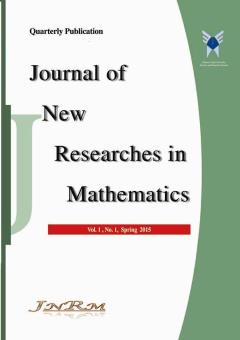کنترل فازی مد لغزشی ترمینال برای سیستمهای چند عاملی غیر خطی رهبر-پیرو
الموضوعات :نگار ایزدی 1 , محمد تقی دستجردی 2
1 - گروه ریاضی، دانشکده علوم، دانشگاه زنجان، زنجان، ایران
2 - گروه ریاضی، دانشکده علوم، دانشگاه زنجان، زنجان، ایران
الکلمات المفتاحية: Fuzzy Controller, Multi-Agent System, Consensus, Terminal Sliding Mode Control,
ملخص المقالة :
در این مقاله، ما یک کنترلکننده مد لغزشی فازی ترمینال را برای سیستمهای چند عاملی رهبر-پیرو غیر خطی مرتبه دوم که دارای عدم قطعیت میباشند ارائه میکنیم. ابتدا یک کنترلکننده مدلغزشی ترمینال را معرفی میکنیم که نه تنها سریع و نامنفرد است، بلکه باعث میشود خطای ردیابی در زمان متناهی روی سطح لغزشی به نقطهی تعادل صفر برسد. علاوه بر این، بهمنظور از بین بردن پدیده چترینگ، یک کنترلکننده فازی برپایه اصول مد لغزشی ترمینال نیز پیشنهاد شده است. کنترل کننده مد لغزشی ترمینال فازی پیشنهادی شرط اجماع را نیز برای سیستم چند عاملی رهبر-پیرو برآورده میکند و سیستم نیز بهمفهوم لیاپانوف به پایداری میرسد. یک مزیت عمده کنترلکننده ارائه شده در این مقاله این است که اگر مقدار خطای اولیه زیاد باشد نیز سیستم در زمان کوتاهی روی سطح لغزشی به نقطه تعادل میرسد. مثال ارائه شده در این مقاله و نتابج شبیهسازی درستی این مطلب را تایید میکنند
[1] G. Antonelli, “Interconnected dynamic systems: An overview on distributed control, “ IEEE Control Systems Magazine. Vol. 33, no. 1, pp. 76–88, 2013.
[2] Y. Cao, W. Yu, W. Ren, and G. Chen “An overview of recent progress in the study of distributed multi-agent coordination.,” EEE Transactions on Industrial Informatics. Vol. 9, no. 1, pp. 427–438, 2013.
[3] J.Y. Hung, W. Gao, and J.C. Hung, “Variable structure control: a survey,” IEEE Transactions on Industrial Electronics, vol. 40, no. 1, pp. 2–22, 1993.
[4] S. Mobayen, V. Johari Majd, and M. Sojoodi, “An lmi-based composite nonlinear feedback terminal sliding-mode controller design for disturbed mimo systems,” Math. Comput. Simul, vol. 85, no. 110, pp. 1–10, 2012.
[5] V. Utkin, “Variable structure systems with sliding modes,” IEEE Transactions on Automatic Control, vol. 22 , no. 2, pp. 212–222, 1977.
[6] S. T. Venkataraman and S. Gulati, “Control of nonlinear systems using terminal sliding modes,” In 1992 American Control Conference. No. 115, pp. 554–560, 1992.
[7] C.W. Tao, J.S. Taur, and M.L. Chan, “Adaptive fuzzy terminal sliding mode controller for linear systems with mismatched time-varying uncertainties,” Cybernetics, vol. 34, no. 1, pp. 255—262, 2004.
[8] K.B. Park and T. Tsuji “Terminal sliding mode control of second-order nonlinear uncertain systems,” International Journal of Robust and Nonlinear Control, vol. 9, no. 11, pp. 769–780, 1999.
[9] M. M. Gulzar, S. T. Hussain Rizvi, M. Yaqoob Javed, U. Munir and H. Asif, “Multi-agent cooperative control consensus: A comparative review,” Electronics. Vol. 7, no. 2, 2018.
[10] R.A. DeCarlo, S.H. Zak, and G.P. Matthews, “Variable structure control of nonlinear multivariable systems: a tutorial,” Proceedings of the IEEE. Vol. 76, no. 3, pp. 212—232, 1988.
[11] C. Edwards and S. Spurgeon, “Sliding Mode Control: Theory And Applications,” CRC Press, London, 1998.
[12] W. Ren and R. W. Beard, Distributed Consensus in Multi-Vehicle Cooperative Control: Theory and Applications, Springer Publishing Company, Incorporated, 1st edition, 2007.
[13] Y. Wu, B. Hu, and Z.H. Guan, “Consensus problems over cooperation-competition random switching networks with noisy channels,” IEEE transactions on neural networks and learning systems, vol. 30, no. 1,pp. 35–43, 2018.
[14] A. Jadbabaie, J. Lin, and A.S. Morse, “Coordination of groups of mobile autonomous agents using nearest neighbor rules,” Automatic Control, IEEE Transactions, vol. 48, no. 6, pp. 988—1001, 2003.
[15] R. Olfati-Saber and R.M. Murray, “Consensus problems in networks of agents with switching topology and time-delays,” IEEE Transactions on Automatic Control, vol. 49, no. 9, pp. 1520 –1533, 2004.
[16] F.L. Lewis, H. Zhang, K. Hengster-Movric, and A. Das. “Cooperative control of multi-agent systems: optimal and adaptive design approaches,” Springer Science & Business Media, 2013.
[17] Y. Zheng, J. Ma, and L. Wang, “Consensus of hybrid multi-agent systems,” IEEE Transactions on Neural Networks and Learning Systems, vol. 29, no. 4, 1359–1365, 2018.
[18] Y. Zheng, Q. Zhao, J. Ma, and L. Wang, “Second-order consensus of hybrid multi-agent systems,” Systems & Control Letters, vol. 125, pp. 51–58, 2019.
[19] K-Y. Zhuang, K-Q. Zhang and H-Y. Su, “Terminal sliding mode control for high-order nonlinear dynamic systems,” Journal-Zhejiang University Engineering Science , vol. 36, no. 5, pp. 482-485, 2002.
[20] y. Feng, X. yu and Z. Man, “Non-singular terminal sliding mode control of rigid manipulators,” Automatica, vol. 38, pp. 2159 –2167, 2002.
[21] Y.J. Mon, “Terminal sliding mode fuzzy-pdc control for nonlinear systems,” Int. J. Sci. Technol. Res, vol. 2, no. 4, pp. 218—221, 2013.
[22] M. Zhihong and X. H. Yu, “Terminal sliding mode control of mimo linear systems”, IEEE Transactions on Circuits and Systems I: Fundamental Theory and Applications, vol. 44, no. 11, pp. 1065–1070, 1997.


